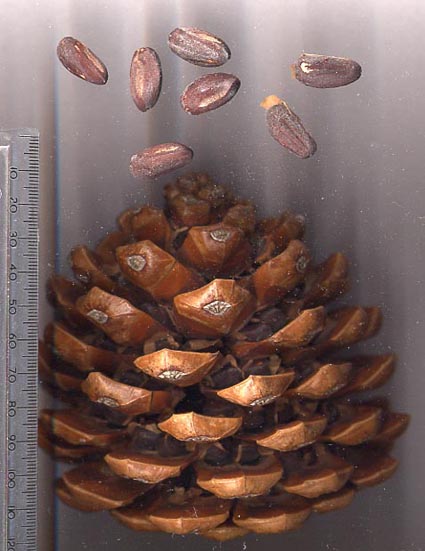|
Pine Nut
Pine nuts, also called piñón (), pinoli (), or pignoli, are the edible seeds of pines (family Pinaceae, genus ''Pinus''). According to the Food and Agriculture Organization, only 29 species provide edible nuts, while 20 are traded locally or internationally owing to their seed size being large enough to be worth harvesting; in other pines, the seeds are also edible but are too small to be of notable value as human food. The biggest producers of pine nuts are China, Russia, North Korea, Pakistan and Afghanistan. As pines are gymnosperms, not angiosperms (flowering plants), pine nuts are not " true nuts"; they are not botanical fruits, the seed not being enclosed in an ovary which develops into the fruit, but simply bare seeds—"gymnosperm" meaning literally "naked seed" (from and ). The similarity of pine nuts to some angiosperm fruits is an example of convergent evolution. Species and geographic spread In Asia, two species, in particular, are widely harvested: Korea ... [...More Info...] [...Related Items...] OR: [Wikipedia] [Google] [Baidu] |
Pinus Pinea
The Italian stone pine, botanical name ''Pinus pinea'', also known as the Mediterranean stone pine is a tree from the pine family (''Pinaceae''). The tree is native to the Mediterranean region, occurring in Southern Europe and the Levant. The species was introduced into North Africa millennia ago, and is also naturalized in the Canary Islands, South Africa and New South Wales. Stone pines have been used and cultivated for their edible pine nuts since prehistoric times. They are widespread in horticultural cultivation as ornamental trees, planted in gardens and parks around the world. This plant has gained the Royal Horticultural Society's Award of Garden Merit. ''Pinus pinea'' is a diagnostic species of the vegetation class ''Pinetea halepensis''. Description The stone pine is a coniferous evergreen tree that can exceed in height, but is more typical. In youth, it is a bushy globe, in mid-age an umbrella canopy on a thick trunk, and, in maturity, a broad and flat crown o ... [...More Info...] [...Related Items...] OR: [Wikipedia] [Google] [Baidu] |
Fruit
In botany, a fruit is the seed-bearing structure in flowering plants (angiosperms) that is formed from the ovary after flowering. Fruits are the means by which angiosperms disseminate their seeds. Edible fruits in particular have long propagated using the movements of humans and other animals in a symbiotic relationship that is the means for seed dispersal for the one group and nutrition for the other; humans, and many other animals, have become dependent on fruits as a source of food. Consequently, fruits account for a substantial fraction of the world's agricultural output, and some (such as the apple and the pomegranate) have acquired extensive cultural and symbolic meanings. In common language and culinary usage, ''fruit'' normally means the seed-associated fleshy structures (or produce) of plants that typically are sweet (or sour) and edible in the raw state, such as apples, bananas, grapes, lemons, oranges, and strawberries. In botanical usage, the term ''fruit'' als ... [...More Info...] [...Related Items...] OR: [Wikipedia] [Google] [Baidu] |
Radio Liberty
Radio Free Europe/Radio Liberty (RFE/RL) is a media organization broadcasting news and analyses in 27 languages to 23 countries across Eastern Europe, Central Asia, the Caucasus, and the Middle East. Headquartered in Prague since 1995, RFE/RL operates 21 local bureaus with over 500 core staff, 1,300 freelancers, and 680 employees. Nicola Careem serves as the editor-in-chief. Founded during the Cold War, RFE began in 1949 targeting Soviet satellite states, while RL, established in 1951, focused on the Soviet Union. Initially funded covertly by the CIA until 1972, the two merged in 1976. RFE/RL was headquartered in Munich from 1949 to 1995, with additional broadcasts from Portugal's Glória do Ribatejo until 1996. Soviet authorities jammed their signals, and communist regimes often infiltrated their operations. Today, RFE/RL is a private 501(c)(3) corporation supervised by the United States Agency for Global Media, which oversees all government-supported international broa ... [...More Info...] [...Related Items...] OR: [Wikipedia] [Google] [Baidu] |
Lacebark Pine
''Pinus bungeana'' (; Japanese: シロマツ; ), also known by the common names Bunge's pine, lacebark pine and white-barked pine, is a pine tree native to northeastern and central China. It is a slow-growing tree that can grow to heights of is frost hardy down to below . Its smooth, grey-green bark gradually sheds in round scales to reveal patches of pale yellow, which turn olive-brown, red and purple on exposure to light. Description The lacebark pine's trunk can grow either monopodial, as a single growth upwards, or sympodial, forked. Its crown is loosely shaped like a pyramid or umbrella. It has long needles in groups of three. Each needles' cross-sections are shaped like a triangular semicircle. The lacebark pine produces cones that turn yellowish brown as they mature and are roughly egg-shaped and long. They contain seeds that are grey-brown, slightly egg-shaped, and long. Taxonomy ''P. bungeana'' is synonymous with the name ''Pinus excorticata'', attributed ... [...More Info...] [...Related Items...] OR: [Wikipedia] [Google] [Baidu] |
Chinese White Pine
''Pinus armandii'', the Armand pine or Chinese white pine, is a species of pine native to China, occurring from southern Shanxi west to southern Gansu and south to Yunnan, with outlying populations in Anhui. It grows at altitudes of 2200–3000 m in Taiwan, and it also extends a short distance into northern Burma. In Chinese it is known as "Mount Hua pine" (). It grows at 1,000–3,300 m altitude, with the lower altitudes mainly in the northern part of the range. It is a tree reaching height, with a trunk up to in diameter. Description It is a member of the white pine group, ''Pinus'' subgenus ''Strobus'', and like all members of that group, the leaves ('needles') are in fascicles (bundles) of five, with a deciduous sheath. They are long. The cones are long and broad, with stout, thick scales. The seeds are large, long and have only a vestigial wing; they are dispersed by spotted nutcrackers. The cones mature in their second year, this is a juvenile female cone: ; Var ... [...More Info...] [...Related Items...] OR: [Wikipedia] [Google] [Baidu] |
Siberian Dwarf Pine
''Pinus pumila'', commonly known as the Siberian dwarf pine, dwarf Siberian pine, dwarf stone pine, Japanese stone pine, or creeping pine, is a tree in the family Pinaceae native plant, native to northeastern Asia and the Japan, Japanese isles. It shares the common name ''creeping pine'' with Creeping pine, several other plants. Description The Siberian dwarf pine is a coniferous evergreen shrub ranging from in height, exceptionally up to , but may have individual branches that extend further along the ground in length. In the mountains of northern Japan, it sometimes hybridizes with the related Japanese white pine (''Pinus parviflora''); these hybrids (''Pinus'' × ''hakkodensis'') are larger than ''P. pumila'', reaching tall on occasion. The leaves are needle-like, formed in bundles of five and are 4–6 centimeters long. The conifer cone, cones are 2.5–4.5cm long, with large nut-like seeds (pine nuts). Distribution The range covers the Far East, Eastern Siberia, n ... [...More Info...] [...Related Items...] OR: [Wikipedia] [Google] [Baidu] |
Siberian Pine
''Pinus sibirica'', or Siberian pine, in the family Pinaceae is a species of pine tree that occurs in Siberia from 58°E in the Ural Mountains east to 126°E in the Stanovoy Range in southern Sakha Republic, and from Igarka at 68°N in the lower Yenisei valley, south to 45°N in central Mongolia. Description ''Pinus sibirica'' is a member of the white pine group, ''Pinus'' subgenus '' Strobus'', and like all members of that group, the leaves ('needles') are in fascicles (bundles) of five, with a deciduous sheath. They are 5–10 cm long. Siberian pine cones are 5–9 cm long. The 9–12 mm long seeds have only a vestigial wing and are dispersed by spotted nutcrackers. Siberian pine is treated as a variety or subspecies of the very similar Swiss pine (''Pinus cembra'') by some botanists. It differs in having slightly larger cones, and needles with three resin canals instead of two in Swiss pine. Like other European and Asian white pines, Siberian pine is ... [...More Info...] [...Related Items...] OR: [Wikipedia] [Google] [Baidu] |
Himalaya
The Himalayas, or Himalaya ( ), is a mountain range in Asia, separating the plains of the Indian subcontinent from the Tibetan Plateau. The range has some of the Earth's highest peaks, including the highest, Mount Everest. More than 100 peaks exceeding elevations of above sea level lie in the Himalayas. The Himalayas abut on or cross territories of six countries: Nepal, China, Pakistan, Bhutan, India and Afghanistan. The sovereignty of the range in the Kashmir region is disputed among India, Pakistan, and China. The Himalayan range is bordered on the northwest by the Karakoram and Hindu Kush ranges, on the north by the Tibetan Plateau, and on the south by the Indo-Gangetic Plain. Some of the world's major rivers, the Indus, the Ganges, and the Tsangpo– Brahmaputra, rise in the vicinity of the Himalayas, and their combined drainage basin is home to some 600 million people; 53 million people live in the Himalayas. The Himalayas have profoundly shaped the cultures of ... [...More Info...] [...Related Items...] OR: [Wikipedia] [Google] [Baidu] |
Chilgoza Pine
''Pinus gerardiana'', commonly known as the chilghoza pine or neja, is a pine species native to parts of central and southern Asia, including the western Himalayas. The International Union for Conservation of Nature (IUCN) listed it as near threatened in 2011. The pine nuts are locally collected for consumption. Description The trees are tall with usually deep, wide and open crowns with long, erect branches. However, crowns are narrower and shallower in dense forests. The bark is very flaky, peeling to reveal light greyish-green patches. The branchlets are smooth and olive-green. The leaves are needle-like, in groups of three, long, and spread stiffly. They are glossy green on the outer surface, with blue-green stomatal lines on the inner face; their sheaths fall in the first year. The cones are long and wide when open, with wrinkled, reflexed apophyses and an umbo curved inward at the base. The seeds (pine nuts) are long and broad, with a thin shell and a rudimentary w ... [...More Info...] [...Related Items...] OR: [Wikipedia] [Google] [Baidu] |
Convergent Evolution
Convergent evolution is the independent evolution of similar features in species of different periods or epochs in time. Convergent evolution creates analogous structures that have similar form or function but were not present in the last common ancestor of those groups. The cladistic term for the same phenomenon is Cladogram#Homoplasies, homoplasy. The recurrent evolution of flight is a classic example, as flying pterygota, insects, birds, pterosaurs, and bats have independently evolved the useful capacity of flight. Functionally similar features that have arisen through convergent evolution are ''analogous'', whereas ''homology (biology), homologous'' structures or traits have a common origin but can have dissimilar functions. Bird, bat, and pterosaur wings are analogous structures, but their forelimbs are homologous, sharing an ancestral state despite serving different functions. The opposite of convergence is divergent evolution, where related species evolve different trai ... [...More Info...] [...Related Items...] OR: [Wikipedia] [Google] [Baidu] |






